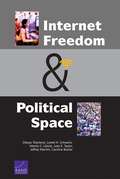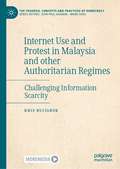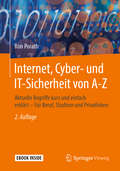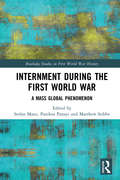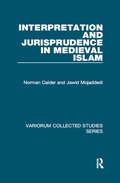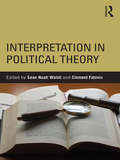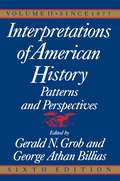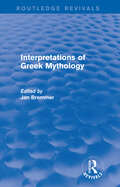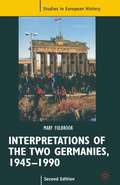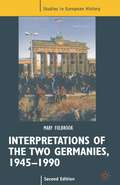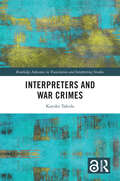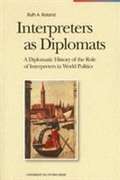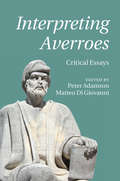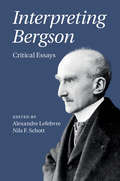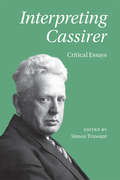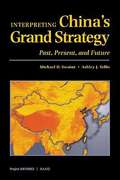- Table View
- List View
Internet Freedom & Political Space
by Lowell H. Schwartz Martin C. Libicki Jeffrey Martini Julie E. Taylor Caroline Baxter Olesya TkachevaThe Internet is a new battleground between governments that censor online content and those who advocate freedom for all to browse, post, and share information online. This report examines how Internet freedom may transform state-society relations in nondemocratic regimes, using case studies of China, Egypt, Russia, and Syria, and also draws parallels between Internet freedom and Radio Free Europe programs during the Cold War.
Internet Literature in China
by Michel HockxRanging from the self-consciously avant-garde to the pornographic, web-based writing has introduced innovative forms, themes, and practices into Chinese literature and its aesthetic traditions.
Internet Today!
by Karen Hartman Ernest AckermannInternet Today! is, as the name implies, a survey of the components and facilities of the Internet; it is also a guide to its use, including a discussion of some features of the Internet, followed by exercises designed to create competence in both understanding and implementing the features. Chapters include: Introduction to the Internet and the World Wide Web; Using a Web Browser; The Basics of Electronic Mail and Using Netscape E-mail; Finding Information on the Web; Directories and Searching; Search Strategies for Search Engines; Writing Your Own Web Pages; Telnet, FTP, and Gopher; Legal Issues, Ethical Issues, Privacy and Security.
Internet Use and Protest in Malaysia and other Authoritarian Regimes: Challenging Information Scarcity (The Theories, Concepts and Practices of Democracy)
by Kris RuijgrokThis book investigates the impact of internet use on anti-government protesting under authoritarian rule. By breaking up the causal chain into various steps, it provides a thorough and nuanced understanding of internet’s role in different stages of the mobilization process. It argues that the impact of internet use on anti-governmental protesting differs per step in the ‘mobilization chain’, and also that the effect depends on both the on- and offline repression of the regime, as well as on the type of internet that is available. While staying far away from any technologically deterministic claims about the internet, the book demonstrates that the internet especially plays an important role in the early stages of the mobilization process: By exposing citizens to alternative political information online, internet users are more likely to become sympathetic towards anti-governmental protest movements.
Internet, Cyber- und IT-Sicherheit von A-Z: Aktuelle Begriffe kurz und einfach erklärt – Für Beruf, Studium und Privatleben
by Ron PorathDie wichtigsten Begriffe zu Internet, Cyber-Risiken, IT-Sicherheit und Datenschutz. Kurz, aktuell, prägnant und einfach zu verstehen. Finden Sie hier schnell und ohne lange Texte lesen zu müssen die Bedeutung von aktuellen und in Zukunft wichtig werdenden Begriffen wie Blockchain, GDPR, Quantencomputer, WannaCry, Hacking, Ransomware oder Künstlicher Intelligenz. Dieses Standardwerk ist schnell zur Hand und darf heutzutage auf keinem Schreibtisch fehlen.
Internment during the First World War: A Mass Global Phenomenon (Routledge Studies in First World War History)
by Panikos Panayi Matthew Stibbe Stefan ManzAlthough civilian internment has become associated with the Second World War in popular memory, it has a longer history. The turning point in this history occurred during the First World War when, in the interests of ‘security’ in a situation of total war, the internment of ‘enemy aliens’ became part of state policy for the belligerent states, resulting in the incarceration, displacement and, in more extreme cases, the death by neglect or deliberate killing of hundreds of thousands of people throughout the world. This pioneering book on internment during the First World War brings together international experts to investigate the importance of the conflict for the history of civilian incarceration.
Interpretation and Jurisprudence in Medieval Islam (Variorum Collected Studies)
by Norman Calder Jawid MojaddediAt the time of his death in 1998, at the age of 47, Norman Calder had become the most widely-discussed scholar in his field. This was largely focused on his monograph, Studies in Early Muslim Jurisprudence (Oxford, 1993), which boldly challenged existing theories about the origins of Islamic Law. The present volume of twenty-one of his articles and book chapters represents the full richness and diversity of Calder's oeuvre, from his initial doctoral research on Shii Islam to his later more philosophical writings on Sunni hermeneutics, in addition to his numerous studies on early Islamic history and jurisprudence. Calder's pioneering research, which was based on a sensitive reading of medieval texts fully informed by contemporary critical theory, often challenged the established assumptions of the day. He is known in particular for urging a reassessment of widely-held prejudices which underestimated the degree of creativity in medieval Islamic scholarship. Many of the articles in this volume have already become classics for the fields of Muslim jurisprudence and hermeneutics.
Interpretation in Political Theory
by Clement Fatovic Sean Noah WalshTheorists interested in learning more about any given interpretive approach are often required to navigate a dizzying array of sources, with no clear sense of where to begin. The prose of many primary sources is often steeped in dense and technical argot that novices find intimidating or even impenetrable. Interpretation in Political Theory provide students of political theory a single introductory reference guide to major approaches to interpretation available in the field today. Comprehensive and clearly written, the book includes: A historical and theoretical overview that situates the practice of interpretation within the development of political theory in the twentieth century. Chapters on Straussian esotericism, historical approaches within the Cambridge School of interpretation, materialist approaches associated with Marxism, the critical approaches associated with varieties of feminism, Greimassian semiotics, Foucaultian genealogy, the negative dialectics of Theodor Adorno, deconstruction as exemplified by Jacques Derrida and Paul de Man, and Lacanian psychoanalysis. An exposition of the theoretical and disciplinary background of each approach, the tools and techniques of interpretation it uses, its assumptions about what counts as a relevant text in political theory, and what it considers to be the purpose or objective of reading in political theory. A reading of Thomas Hobbes’s Leviathan to illustrate how each approach can be applied in practice. A list of suggestions for further reading that will guide those interested in pursuing more advanced study. An invaluable textbook for advanced undergraduates, graduate students, and even seasoned scholars of political theory interested in learning more about different interpretive approaches.
Interpretations of American History, 6th Ed, Vol. 2 (Since #1877)
by Gerald N. Grob George Athan BilliasThis collection of essays on American history reflects recent scholarship. Contributors new to this edition include Gary Nash, Arthur Schlesinger, Richard P. McCormick, Gerda Lerner, Ellen C. DuBois, Vicki L. Ruiz, Nathan I. Huggins, John Lewis Gaddis, Paul Kennedy and Kevin P. Philips. Edited by Gerald N. Grob and George Athan Billias.
Interpretations of Greek Mythology (Routledge Revivals)
by Jan N. BremmerInterpretations of Greek Mythology, first published in1987, builds on the innovative work of Walter Burkert and the ‘Paris school’ of Jean-Pierre Vernant, and represents a renewal of interpretation of Greek mythology. The contributors to this volume present a variety of approaches to the Greek myths, all of which eschew a monolithic or exclusively structuralist hermeneutic method. Specifically, the notion that mythology can simply be read as a primitive mode of narrative history is rejected, with emphasis instead being placed on the relationships between mythology and history, ritual and political genealogy. The essays concentrate on some of the best known characters and themes – Oedipus, Orpheus, Narcissus – reflecting the complexity and fascination of the Greek imagination. The volume will long remain an indispensable tool for the study of Greek mythology, and it is of great interest to anyone interested in the development of Greek culture and civilisation and the nature of myth.
Interpretations of History: From Confucius to Toynbee (Routledge Library Editions: Historiography)
by Alban G. WidgeryIn this volume, originally published in 1961, the author presents an exposition of the meanings given to history. Part 1 describes the conceptions of history impied in wide-spread religions and cultures, Confucian and Taoist, Hindu and Buddhist, Zoroastrian and Muslim, Greek and Roman, Jewish and Christian. Part 2 surveys the theories of independent thinkers and schools in the Occident from the Middle Ages to the mid-twentieth century.
Interpretations of the Two Germanies
by Mary FulbrookThe two Germanies, arising from the unpromising ashes of defeated Nazi Germany, came to represent opposing models of state and society. The Federal Republic established itself as a remarkably stable democracy and successful social market economy: the German Democratic Republic developed an apparently exemplary form of 'actually existing socialism' and became a pillar of the Soviet bloc. Then in 1989, the 'gentle revolution' in East Germany added a new twist with the collapse of Communist rule. With rapid reunification, the united Germany of 1990 faced new challenges as the unprecedented transformation created a multitude of economic problems and social tensions. Previously published in 1992 as The Two Germanies, this book has been fully revised and updated to take account of all the latest developments in contemporary German history.
Interpretations of the Two Germanies, 1945-1990: Problems Of Interpretation (Studies in European History)
by Mary FulbrookThe two Germanies, arising from the unpromising ashes of defeated Nazi Germany, came to represent opposing models of state and society. The Federal Republic established itself as a remarkably stable democracy and successful social market economy: the German Democratic Republic developed an apparently exemplary form of 'actually existing socialism' and became a pillar of the Soviet bloc. Then in 1989, the 'gentle revolution' in East Germany added a new twist with the collapse of Communist rule. With rapid reunification, the united Germany of 1990 faced new challenges as the unprecedented transformation created a multitude of economic problems and social tensions.Previously published in 1992 as The Two Germanies, this book has been fully revised and updated to take account of all the latest developments in contemporary German history.
Interpreters and War Crimes (Routledge Advances in Translation and Interpreting Studies)
by Kayoko TakedaTaking an interdisciplinary approach, this book raises new questions and provides different perspectives on the roles, responsibilities, ethics and protection of interpreters in war while investigating the substance and agents of Japanese war crimes and legal aspects of interpreters’ taking part in war crimes. Informed by studies on interpreter ethics in conflict, historical studies of Japanese war crimes and legal discussion on individual liability in war crimes, Takeda provides a detailed description and analysis of the 39 interpreter defendants and interpreters as witnesses of war crimes at British military trials against the Japanese in the aftermath of the Pacific War, and tackles ethical and legal issues of various risks faced by interpreters in violent conflict. The book first discusses the backgrounds, recruitment and wartime activities of the accused interpreters at British military trials in addition to the charges they faced, the defence arguments and the verdicts they received at the trials, with attention to why so many of the accused were Taiwanese and foreign-born Japanese. Takeda provides a contextualized discussion, focusing on the Japanese military’s specific linguistic needs in its occupied areas in Southeast Asia and the attributes of interpreters who could meet such needs. In the theoretical examination of the issues that emerge, the focus is placed on interpreters’ proximity to danger, visibility and perceived authorship of speech, legal responsibility in war crimes and ethical issues in testifying as eyewitnesses of criminal acts in violent hostilities. Takeda critically examines prior literature on the roles of interpreters in conflict and ethical concerns such as interpreter neutrality and confidentiality, drawing on legal discussion of the ineffectiveness of the superior orders defence and modes of individual liability in war crimes. The book seeks to promote intersectoral discussion on how interpreters can be protected from exposure to manifestly unlawful acts such as torture.
Interpreters as Diplomats: A Diplomatic History of the Role of Interpreters in World Politics
by Ruth A. RolandThis book looks at the role played throughout history by translators and interpreters in international relations. It considers how political linguistics function and have functioned throughout history.
Interpreting Ancient Figurines
by Richard G. LesureThis book examines ancient figurines from several world areas to address recurring challenges in the interpretation of prehistoric art. Sometimes figurines from one context are perceived to resemble those from another. Richard G. Lesure asks whether such resemblances play a role in our interpretations. Early interpreters seized on the idea that figurines were recurringly female and constructed the fanciful myth of a primordial Neolithic Goddess. Contemporary practice instead rejects interpretive leaps across contexts. Dr. Lesure offers a middle path: a new framework for assessing the relevance of particular comparisons. He develops the argument in case studies that consider figurines from Paleolithic Europe, the Neolithic Near East, and Formative Mesoamerica.
Interpreting Art in Museums and Galleries
by Christopher WhiteheadIn this pioneering book, Christopher Whitehead provides an overview and critique of art interpretation practices in museums and galleries. Covering the philosophy and sociology of art, traditions in art history and art display, the psychology of the aesthetic experience and ideas about learning and communication, Whitehead advances major theoretical frameworks for understanding interpretation from curators’ and visitors’ perspectives. Although not a manual, the book is deeply practical. It presents extensively researched European and North American case studies involving interviews with professionals engaged in significant cutting-edge interpretation projects. Finally, it sets out the ethical and political responsibilities of institutions and professionals engaged in art interpretation. Exploring the theoretical and practical dimensions of art interpretation in accessible language, this book covers: The construction of art by museums and galleries, in the form of collections, displays, exhibition and discourse; The historical and political dimensions of art interpretation; The functioning of narrative, categories and chronologies in art displays; Practices, discourses and problems surrounding the interpretation of historical and contemporary art; Visitor experiences and questions of authorship and accessibility; The role of exhibition texts, new interpretive technologies and live interpretation in art museum and gallery contexts. Thoroughly researched with immediately practical applications, Interpreting Art in Museums and Galleries will inform the practices of art curators and those studying the subject.
Interpreting Averroes: Critical Essays
by Peter Adamson Matteo Di GiovanniThis volume brings together world-leading scholars on the thought of Averroes, the greatest medieval commentator on Aristotle but also a major scholar of Islam. The collection situates him in his historical context by emphasizing the way that he responded to the political situation of twelfth-century Islamic Spain and the provocations of Islamic theology. It also sheds light on the interconnections between aspects of his work that are usually studied separately, such as his treatises on logic and his legal writings. Advanced students and scholars will find authoritative and insightful treatments of Averroes' philosophy, tackled from multiple perspectives and written in a clear and accessible way that will appeal to those encountering his work for the first time as well as to anyone looking for new critical approaches to Averroes and his thinking.
Interpreting Avicenna
by Peter AdamsonAvicenna is the greatest philosopher of the Islamic world. His immense impact on Christian and Jewish medieval thought, as well as on the subsequent Islamic tradition, is charted in this volume alongside studies which provide a comprehensive introduction to and analysis of his philosophy. Contributions from leading scholars address a wide range of topics including Avicenna's life and works, conception of philosophy and achievement in logic and medicine. His ideas in the main areas of philosophy, such as epistemology, philosophy of religion and physics, are also analyzed. While serving as a general introduction to Avicenna's thought, this collection of critical essays also represents the cutting edge of scholarship on this most influential philosopher of the medieval era.
Interpreting Bergson: Critical Essays
by Alexandre Lefebvre Nils F. SchottBergson was a pre-eminent European philosopher of the early twentieth century and his work covers all major branches of philosophy. This volume of essays is the first collection in twenty years in English to address the whole of Bergson's philosophy, including his metaphysics, epistemology, philosophy of science, philosophy of life, aesthetics, ethics, social and political thought, and religion. The essays explore Bergson's influence on a number of different fields, and also extend his thought to pressing issues of our time, including philosophy as a way of life, inclusion and exclusion in politics, ecology, the philosophy of race and discrimination, and religion and its enduring appeal. The volume will be valuable for all who are interested in this important thinker and his continuing relevance.
Interpreting Buridan: Critical Essays
by Henrik Lagerlund Spencer JohnstonJohn Buridan (d. 1362) is one of the great thinkers of the later Middle Ages. He is perhaps best known for his contributions to logic, but the range of his thought is wide. This volume of new essays, written by leading Buridan scholars, places Buridan in his philosophical context and examines his writings on logic, modal logic, paradoxes, metaphysics, epistemology, and natural philosophy. It also introduces several new topics of discussion that have not so far been dealt with in scholarship on Buridan, such as his theory of knowledge, his view of artefacts, his conception of women, his writing on emotions, and his moral philosophy. Together the essays produce a rich picture of Buridan's thought and underline the continuing relevance of his philosophical concerns.
Interpreting Cassirer: Critical Essays
by Simon TruwantThis is the first comprehensive volume in English on Cassirer's philosophy for over seventy years. Eleven leading Cassirer scholars address all of the key aspects of Cassirer's multi-faceted thought and situate them in the wider context of his philosophy of culture. Their essays demonstrate the depth and richness of a philosophical enterprise that still awaits recognition as one of the most original contributions to twentieth-century philosophy. Interpreting Cassirer will prove invaluable not only for Cassirer scholars and researchers of early twentieth-century philosophy, but also for scholars of the philosophy of culture, language, science, art, history, and mind.
Interpreting China as a Regional and Global Power
by Bart DesseinUntil the 19th century, Confucian China was arguably the most important economic and political power in East and Southeast Asia. The fall of the Confucian empire in the early 20th century paved the way for the development of Chinese nationalism which was seen as the only means by which the country could regain its importance as a regional and global power. The changing position of contemporary China in the world and the revaluation of Confucianism combined with nationalist and patriotic tendencies, brings into question the role that historical consciousness plays in China's national and international identity. This important collection discusses the history of Chinese nationalism and the issue of traditionalism vs. modernity in Chinese political thinking, and investigates the geopolitical impact of China's rise in its immediately adjacent regions, as well as its functioning in organizations of global governance. It thus assesses China's contemporary national and international identity against the background of its Confucian and nationalist history.
Interpreting China's Grand Strategy: Past, Present, and Future
by Sara A. Daly Peter W. Greenwood Michael D. SwaineChina's continuing rapid economic growth and expanding involvement in global affairs pose major implications for the power structure of the international system. To more accurately and fully assess the significance of China's emergence for the United States and the global community, it is necessary to gain a more complete understanding of Chinese security thought and behavior. This study addresses such questions as: What are China's most fundamental national security objectives? How has the Chinese state employed force and diplomacy in the pursuit of these objectives over the centuries? What security strategy does China pursue today and how will it evolve in the future? The study asserts that Chinese history, the behavior of earlier rising powers, and the basic structure and logic of international power relations all suggest that, although a strong China will likely become more assertive globally, this possibility is unlikely to emerge before 2015-2020 at the earliest. To handle this situation, the study argues that the United States should adopt a policy of realistic engagement with China that combines efforts to pursue cooperation whenever possible; to prevent, if necessary, the acquisition by China of capabilities that would threaten America's core national security interests; and to remain prepared to cope with the consequences of a more assertive China.
Interpreting China's Military Power: Doctrine Makes Readiness (Cass Military Studies)
by Ka Po NgAlthough inter-state tensions have generally been easing after the Cold War, military power remains a dominant factor in Asian regional politics. As China, operating the world's largest army, grows stronger, there are ongoing debates over the implications for Asia's regional security. This book argues that it is imperative to look beyond the empirical observations and conventional materialist reading of Chinese military development to understand its dynamics and directions in doctrinal terms and put it in a readiness context for evaluation. Military doctrine has long been under-studied and is often treated as a subject separate from force development. But, as this study contends, this factor is necessary for interpreting the making and purposes of China's military power because it forms the intellectual foundation of military structural and hardware development. When loaded with political rhetoric, it also communicates to us the intended uses of the military power. The role of doctrine is reinforced in the context of military readiness, which defines what for and how the army is getting ready. Force development is evaluated in structural, operational and directional terms.The importance of this analytical framework based on military doctrine and readiness is demonstrated in a survey of the evolutionof Chinese military doctrine and force development. As the Chinese People's Liberation Army has continued to adjust its military structure and operation to follow the doctrinal lead, its switches between the doctines of local war and total war have seen corresponding changes to the emphasis between operational and structural readiness.
